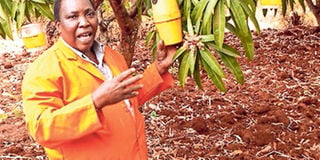Fruit fly traps see mango farmer smiling all the way to the bank

John Ngung'u on his mango farm in Murang'a County. Fruit flies are destructive and are the worst enemies of mangoes. PHOTO | SAMMY WAWERU | NATION MEDIA GROUP
What you need to know:
- Each of the trees has two or three yellow and white plastic containers hanging on one of the stems. These are traps for curbing fruit flies in particular.
- Affected mangoes normally have a bitter taste and produce some sticky sap, making them unfit for consumption.
- On average, Nduati says each container traps about 1,000 fruit flies per day, noting that with the technique, farmers are spending farm much less money than when using pesticides.
- Other pests that affect mangoes include seed weevils, thrips and spider mites. Diseases are anthracnose, powdery mildew, rust and end rot.
John Ndung’u’s farm, located a few metres from the Nairobi-Nyeri highway in Murang’a County, hosts tens of mango trees.
The Seeds of Gold team finds him on the two acres dressed in an orange overcoat, and he is scouting for pests now that the harvesting season ended.
“I have commenced preparing the trees for the next season,” says Ndung’u, who has 180 trees.
Each of the trees has two or three yellow and white plastic containers hanging on one of the stems. These are traps for curbing fruit flies in particular.
“Fruit flies are very destructive and they are the worst enemies of mangoes. They don’t allow them to mature,” explains the farmer, who started growing the fruits in 1998 on half an acre.
Apart from mangoes, fruit flies also attack oranges and other citrus fruits and pumpkins.
Normally, the insects enter the fruits and lay eggs inside, which hatch and make the pests difficult to control.
The fruits then start ripening while still young, according to Ndung’u, and then fall from the tree.
Affected mangoes normally have a bitter taste and produce some sticky sap, making them unfit for consumption.
“Fruit flies usually camp on trees at the onset of flowering, through to the fruiting stage. Affected fruits also have black spots all over,” he says, adding that the defects also affect quality and grading as buyers decline such mangoes.
MUCH LESS MONEY
But with his traps, Ndung’u has managed to curb the pest. “I usually place the pheromone traps on trees when flowering begins. They contain chemicals to attract the male flies and kill them, thus preventing mating.” Ndung’u says that an acre offers him 24,000 mango fruits per season. “I sell the fruits to export agents at Sh7 a piece,” says the farmer, who grows Tommy, Kent and Sabine varieties.
Simon Nduati, an agronomist in Murang’a, says each trap has two holes on the lid.
“The traps are hooked on the mango tree, two on each. Upon smelling the chemicals, the male fruit flies enter the pheromone trap and end up dying inside,” he explains.
On average, Nduati says each container traps about 1,000 fruit flies per day, noting that with the technique, farmers are spending farm much less money than when using pesticides.
Each trap costs Sh350 and lasts for up to four years. “A trap requires chemicals worth Sh250 and they are applied after every three months,” he says.
But farmers can also make their own traps and then buy the scented chemicals. However, for the method to be effective, a farmer and his neighbours must use the traps.
“If your neighbours don’t employ the same method, then their farms become the hiding den for the destructive insects,” says Nduati.
Other pests that affect mangoes include seed weevils, thrips and spider mites. Diseases are anthracnose, powdery mildew, rust and end rot.
“Mangoes need frequent scouting for pests. Apart from using traps and chemicals, the trees should be pruned immediately after harvest. Also discard or burn affected fruits,” he says.





